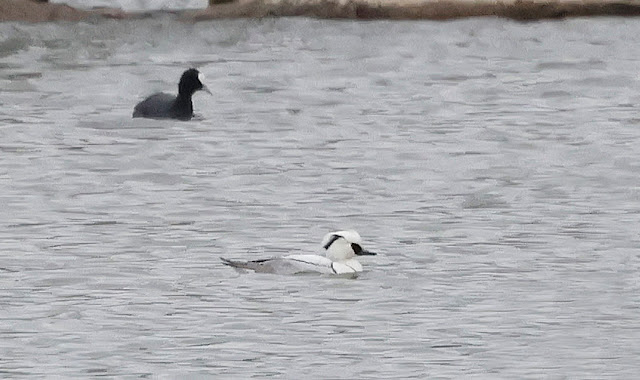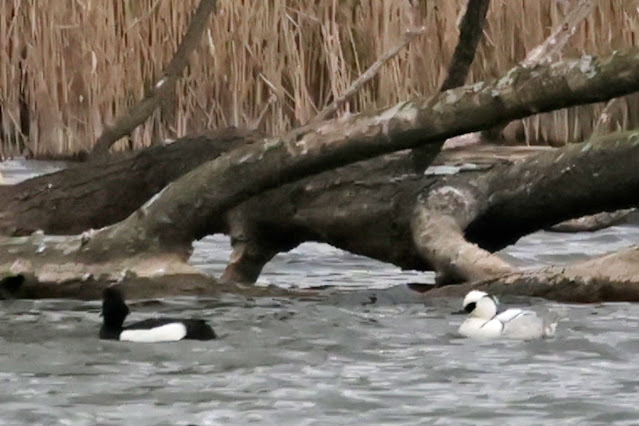So there I am in Winchester on a bus pass shopping trip when my phone goes off, "drake Smew" reported from Fishlake Meadows. My first thought what the hell could that be confused with and this started a rather heated debate on the chat. It was mostly centred around the credibility of the report. But then a message comes in, "it is definitely a Smew, seen photos" and then a back of camera image of what was most definitely a drake Smew.
I was calm as the debate continues along the lines of was it an escape. On the bus back home there was a video come in of the Smew at the back of the lake at Fishlake, seen from the viewing point. This sparked more debate, "not typical Smw behaviour" etc. I decided I had to go, not least because a drake Smew is a stunning bird at the best of times, escape or not.
When I arrived at the car park it wasn't as busy as I expected. I set off along the canal path to the road and then up to the second viewing point by the bus stop. I was told it had just swam out of view, I waited and noticed a pair of Common Terns on the dead trees.
I didn't have to wait long as the Smew appeared from the left hand side and out into the open water. Unfortunately it was distant and these are going to be only record shots unfortunately.
Drake Smews are sometimes known as 'white nuns' because their
crest and pale plumage gives them the impression of wearing a white hood. It came into the open water and I was told this was the closest it had come so far.
A stunning duck, no matter what the provenance and a treat to see.
The smew is a small sawbill, a group of ducks named for
their serrated bills. They're diving ducks, which spend a lot of time under the
water hunting for food - mostly aquatic insects in summer and small fish in
winter.
It moved back and forth almost hiding behind the dead boughs in the water. At times it would associate with a couple of Tufted Duck.
The skies darkened and with it came a huge flock of hirundines. Mostly Sand Martin there were also Swallows and a few House Martins. Large numbers were high in the sky while others hawked low over the water.
Its not often you get to see a Great Egret and Smew in the same view.
the darken skies helped darken the water and provide some welcome contrast to accentuate the Smew's plumage.
The number of smews reaching the UK each winter has
decreased dramatically in recent decades and they are now considered a scarce
visitor. In the mid 20th century, hundreds would spend the winter here, with a
record 144 counted at a single London reservoir in 1956. By contrast, in 2019
it was estimated that only 130 smews wintered in the whole of Britain. This
decrease has been attributed to the effects of climate change, with warmer
winters meaning the birds don't need to travel as far from their breeding grounds
to escape freezing conditions. However, smews are very prone to move around in
winter in response to the weather conditions, so spells of very cold weather on
the continent can push more across the North Sea to the UK.
This would be the lates drake Smew recorded in Hampshire by five days, a fact along with the reduction in recent reports, that fueled the date over the provenance of this duck. Later in the evening it was claimed that one observer had seen a yellow ring, however there is no photographic evidence to support this and as such I see no reason to question the legitimacy. A stunning bird that kept its distance.
The number if hirundine dropped away as the skies lightened ut I did manage this House Martin.
I walked around to the canal path and scanned across the reeds and open water. From here I could see several more hirundine and in amongst them a single Swift, my first of the year.
Despite the controversy, I am glad I made the effort to see the Smew. Now a very rare bird in the UK, let alone Hampshire and a drake is always worth going that little bit extra for.











No comments:
Post a Comment